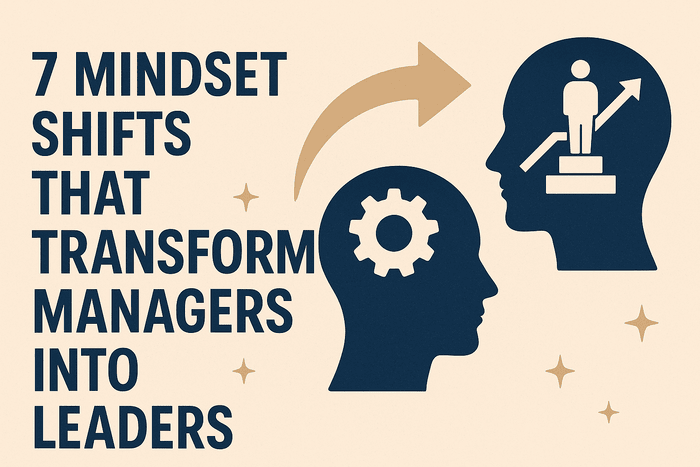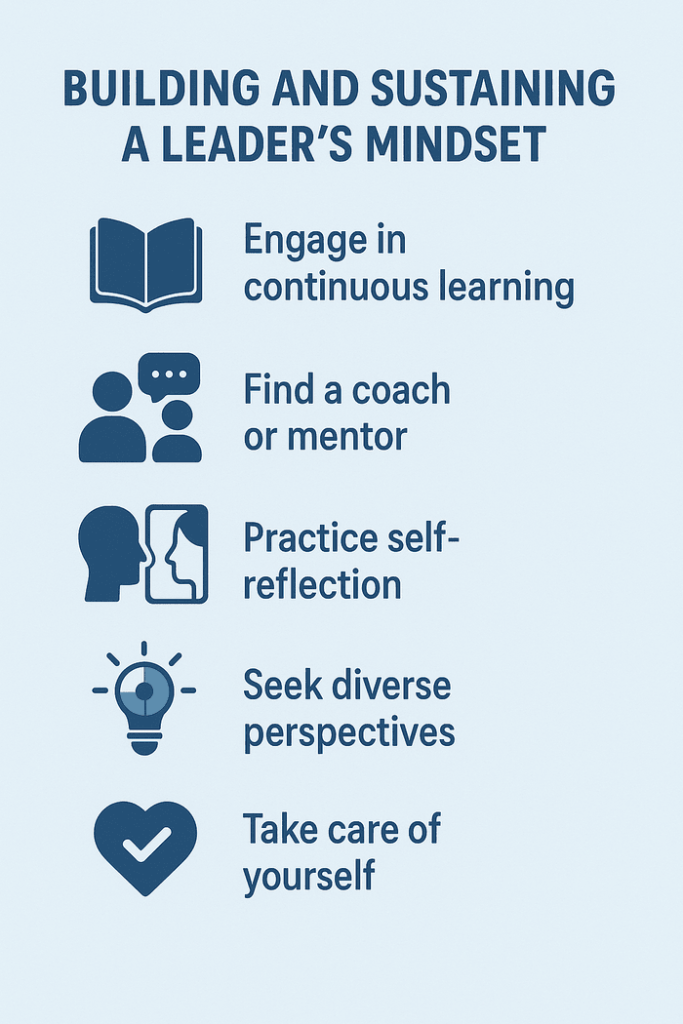
India’s economy has transformed dramatically over the last decade, and the demand for top business coach India services has grown...
Getting promoted into management is often seen as the culmination of years of hard work. Yet for many new managers, the celebration is short‑lived. What made them successful as individual contributors—expertise, hands‑on problem solving and personal achievement—can undermine their success in a leadership role. The transition from manager to leader is less about acquiring new technical skills and more about making profound mindset shifts. This article explores seven transformational shifts identified by leadership experts that will help you evolve from doing the work to orchestrating it, from seeking personal success to enabling the success of others. We’ll also examine additional mental shifts beyond the core seven, review common challenges and offer practical strategies and case studies to help you internalise your new role.

Before diving into the specific shifts, it’s important to understand why mindset is so critical. Leadership researcher Carol Dweck’s concept of a growth mindset shows that how we think about our abilities influences our performance. A fixed mindset—believing that abilities are static—can limit development, whereas a growth mindset encourages learning and adaptation. Similarly, the mindsets we hold about our role in the workplace shape our behaviours. The shift from manager to leader requires rethinking your identity: you move from being an individual contributor who excels at tasks to someone who orchestrates the success of a team. Leadership involves setting direction, creating psychological safety, fostering autonomy and developing people. Making these mental adjustments is not automatic; it takes deliberate reflection and practice.
In 2020, Daniel Stewart wrote an article titled “7 Mindset Shifts that will make you a great manager,” highlighting how habits from individual contributor roles can hinder success at the next level . The seven shifts he outlines serve as a blueprint for anyone moving into management: Doing to Delegating, One Way to Many Ways, Solving Problems to Anticipating Problems, Defined to Ambiguous, Friend to Friendly, Success for Self to Success for Others, and Agenda Doer to Agenda Setter . Each shift represents a change in perspective that unlocks a corresponding set of leadership behaviours.
As an individual contributor, you were promoted because you were great at getting things done. But management is not an elevated version of the same job; it’s a fundamentally different job. You are now responsible for delivering results through other people. Delegation is the mechanism that allows you to multiply your impact. Without it, you become the bottleneck: overwhelmed, controlling and unable to focus on strategic priorities.
Stewart notes that new managers often struggle with delegation because they haven’t let go of the mindset that helped them succeed before . They continue to carry out tasks themselves rather than assigning them to team members, often out of fear that the work won’t be done right. The article suggests rewriting your to‑do list to include tasks only you can do—such as setting expectations, coaching and follow‑up—and delegating the rest .
High‑performing individual contributors often develop strong opinions about the “right way” to accomplish tasks. However, leadership requires openness to diverse approaches. In complex and creative work, multiple paths can lead to success. Transitioning to management means recognising that your way is not the only way. Encouraging variety improves problem solving and empowers your team to contribute meaningfully.
Stewart emphasises that effective managers move from believing there is one right answer to being open to many right answers . He recommends focusing on communicating what needs to be accomplished and why it matters, while giving team members autonomy in deciding how to do it . This fosters ownership and innovation.
Individual contributors spend much of their time solving problems and troubleshooting. Managers, on the other hand, must learn to anticipate problems before they arise and enable their team to prevent roadblocks. This shift is critical because it moves you from reactive to proactive leadership. It allows you to allocate resources effectively, mitigate risks and provide your team with the information they need to plan ahead.
Stewart explains that managers must transition from personally solving problems to helping their team solve problems . He recommends sharing information from higher‑level meetings and other departments so that your team can anticipate changes in the business environment . This proactive communication helps team members prepare for what’s ahead.
Tasks at the individual contributor level are often clearly defined: complete this report, fix this bug, design this module. Management, however, is rife with ambiguity. Objectives may be fuzzy, and success depends on navigating interpersonal dynamics, shifting priorities and evolving organisational goals. Learning to be comfortable in the gray area is essential. If you insist on a detailed roadmap before taking action, you’ll stagnate. Leadership is about making decisions with incomplete information and adapting as new data emerges.
The article notes that managers must become comfortable with ambiguity and complexity. Challenges become less clear‑cut and often involve people rather than technical tasks . Stewart advises new managers to seek support from mentors, HR and other resources when they encounter situations without obvious solutions .
Strong relationships are essential for effective teamwork. However, when you become a manager, the dynamics change. You still need to build trust and rapport, but you must also make tough decisions, provide candid feedback and represent the organisation’s interests. Confusing friendliness with friendship can blur boundaries and erode your authority. Striking a balance between being approachable and maintaining professional distance is critical.
Stewart highlights that managers must be cautious about developing too strong a friendship with their direct reports . You are always an agent of the organisation, and this role can create tension when making unpopular decisions. Maintaining clear boundaries protects both you and your team.
In your previous role, success may have been measured by personal achievements: meeting quotas, completing projects ahead of schedule or receiving praise for your work. As a manager, your success is inseparable from your team’s success. This shift requires you to redefine your sense of accomplishment and to derive satisfaction from enabling others to excel.
Stewart points out that managers must shift their focus to recognising and celebrating the success of their team . Providing positive feedback and supporting your team’s strengths becomes a daily practice. This fosters engagement and builds a culture of appreciation .
As an individual contributor, your job was to execute tasks on someone else’s agenda. Now, as a manager, you are responsible for defining priorities, aligning them with organisational strategy and ensuring your team stays focused on what matters most. Shifting from doer to agenda setter requires strategic thinking, political awareness and the ability to balance competing demands.
Stewart notes that managers must rank priorities, determine how to allocate time and attention and align work with customers’ needs . This shift moves you from reactive task management to proactive strategic planning.
New managers often struggle to transition from being the technical expert to being a coach. This shift means moving away from providing answers and towards asking questions that help team members find solutions. The coaching mindset aligns with the solution‑focused approach described earlier: trust that your team has the capacity to solve problems and support them in discovering their own answers. Adopting a coaching mindset builds capability and confidence in your team and frees up your time for strategic work.
Leaders must balance immediate results with long‑term sustainability. Focusing exclusively on quarterly metrics can lead to burnout, poor quality or missed opportunities for innovation. Shifting to a long‑term perspective involves investing in people, processes and culture that may not pay off immediately but create lasting value. It means considering the broader impact of decisions on customers, communities and the environment. Cultivating a long‑term mindset helps leaders build resilient organisations.
Many new managers fall into the hero trap: they swoop in to save the day, fix problems themselves and receive praise. While this may feel gratifying, it undermines your team’s confidence and builds dependency. A more sustainable mindset is that of an architect who designs systems, structures and cultures that enable people to solve their own problems. This shift requires stepping back, analysing root causes and creating processes that prevent crises rather than firefighting them.
Traditional management emphasised control: managers directed every step and measured compliance. Modern leadership research, however, shows that empowerment—granting autonomy, encouraging initiative and involving team members in decision‑making—leads to higher engagement and performance. This shift involves trusting your team, giving up some control and focusing on outcomes rather than micromanaging processes. Empowerment also improves adaptability; autonomous teams respond more quickly to change because they don’t have to wait for instructions from above.
Scarcity thinking—believing that resources, opportunities and recognition are limited—can lead to hoarding, competition and fear. Leaders with an abundance mindset see possibilities, foster collaboration and share credit. They recognise that success is not a zero‑sum game. Embracing abundance encourages innovation and resilience; when people believe there is enough to go around, they are more willing to support each other and take risks.
Many new managers feel like imposters. They doubt their ability to lead and fear being exposed as unqualified. Recognising that these feelings are common is the first step to overcoming them. Seek mentorship, invest in leadership development and practice self‑compassion. Remember that growth takes time and that even seasoned leaders experience moments of self‑doubt.
Maintaining authority while remaining approachable can be tricky. Overcompensating in either direction—becoming aloof or overly familiar—undermines trust. Be clear about expectations, give constructive feedback and be open to hearing employees’ concerns. Adopt a servant leadership mindset: lead with empathy and humility while upholding standards.
Managers must handle conflict, deliver negative feedback and mediate disputes. Avoiding these conversations for fear of harming relationships only allows problems to fester. Use frameworks like non‑violent communication or Radical Candor to provide direct feedback with care. Prepare for difficult conversations by clarifying the behaviour, impact and desired change. Listen actively and collaborate on solutions.
With new responsibilities, managers often feel stretched thin. Time management is critical. Use tools like Eisenhower’s Urgent/Important matrix to prioritise tasks. Set boundaries to protect deep work time and avoid constant fire‑fighting. Delegate effectively and say no to requests that don’t align with your strategic agenda.
Priya was a highly competent software engineer promoted to lead a team of six developers. In her first months as a manager, she continued to write code and solve technical problems herself. She reviewed every line her team wrote, corrected their mistakes and set tight deadlines. Morale plummeted, and turnover increased. After receiving feedback from her manager, Priya realised she hadn’t made the necessary mindset shifts. She attended a leadership workshop where she learned about the seven shifts and decided to implement them.
Priya began by delegating tasks based on her team members’ strengths and meeting regularly to set goals and clarify expectations. She stopped rewriting their code and instead coached them through their own debugging process. She created a risk review session every Friday where the team anticipated problems. She learned to live with ambiguity and empowered her team to make decisions about implementation details. Within six months, productivity and job satisfaction improved significantly. The team delivered a complex project on time, and Priya felt fulfilled as a leader.
Rohit was a sales superstar. After smashing targets for five years, he was promoted to sales manager. However, he continued to chase deals himself and rarely joined his team’s client meetings. He assumed that because he knew how to close deals, the best way to hit the numbers was to do it himself. As a result, his team felt neglected and underdeveloped. When targets were missed, Rohit blamed his team.
At a leadership retreat, Rohit learned the shift from success for self to success for others. He implemented a new approach: he set team quotas rather than personal quotas, joined meetings as a coach rather than the closer, and invested time in training his team on his proven sales techniques. He celebrated small wins publicly and provided constructive feedback regularly. Over the next year, his team’s performance surpassed his previous individual record, and he received recognition for building a high‑performing team.
Fatima was an operations manager at a rapidly growing start‑up. Her role was initially well defined, but as the company grew, responsibilities became ambiguous. She found herself juggling supplier negotiations, staffing, regulatory compliance and product launches. Instead of panicking, Fatima viewed the ambiguity as an opportunity to learn and shape her role. She sought mentors, used decision‑making frameworks to prioritise tasks and delegated effectively. She encouraged her team to anticipate problems and brainstorm solutions during weekly meetings. As a result, the start‑up navigated expansion smoothly, and Fatima was promoted to director of operations.

Mindset shifts do not happen overnight. They require continuous reflection, feedback and learning. Here are strategies to sustain your journey:
Transitioning from manager to leader is one of the most challenging and rewarding journeys in your career. It requires you to let go of practices that served you well and embrace new mindsets that enable others to thrive. The seven shifts highlighted by Daniel Stewart—delegating, embracing diverse approaches, anticipating problems, living with ambiguity, maintaining friendly boundaries, celebrating team success and setting the agenda—provide a practical roadmap . Building on these foundations with additional shifts such as adopting a coaching mindset, thinking long‑term and viewing yourself as an architect rather than a hero will deepen your leadership practice.
Remember, mindset shifts are ongoing. You will likely oscillate between old habits and new ways of thinking as you learn. That’s normal. What matters is your willingness to reflect, learn and recommit to the leader you aspire to be. When you change how you think, you change how you lead—and that transformation ripples out to your team, your organisation and beyond.
Mindset shapes behavior and performance. A growth mindset encourages learning and adaptation, enabling managers to shift from task-focused individual contributors to leaders who orchestrate team success, set direction, and foster autonomy.
This shift involves moving from performing tasks yourself to empowering others through delegation. It’s crucial to avoid becoming a bottleneck, free up time for strategic priorities, and develop team capabilities.
Embracing diverse approaches instead of insisting on a single "right way" fosters innovation, empowers team members, and improves problem-solving by valuing varied perspectives and methods.
Leaders proactively identify and prevent issues rather than just reacting to them. This involves sharing information, holding risk reviews, and empowering teams to anticipate challenges, enhancing efficiency and preparedness.
Combat imposter syndrome by seeking mentorship, practicing self-compassion, and engaging in continuous learning. Reflect regularly, journal insights, and build a support network to reinforce confidence and growth.

India’s economy has transformed dramatically over the last decade, and the demand for top business coach India services has grown...

When searching for a certified life coach program price, it’s natural to start by comparing tuition fees. Aspiring coaches want...

Neuro-Linguistic Programming (NLP) is experiencing a resurgence in India. Social media, workshops and high-energy seminars promise instant breakthroughs by rewiring...

Many professionals pursue the title of Certified Organizational Development Coach with the expectation that a credential alone will open corporate...

Some providers offer to fast-track you to PCC status through purely online modules for a fraction of the cost of...

Executive coaching has evolved from a niche service for struggling leaders into a strategic investment for organisations aiming to build...

When prospective coaches research training options, cost is often the first number they look for. A quick internet search produces...

Deciding to invest in life coach training programmes can be a transformative milestone in your personal and professional journey. In...

Choosing the right online life coaching courses can be one of the most transformative decisions you ever make.